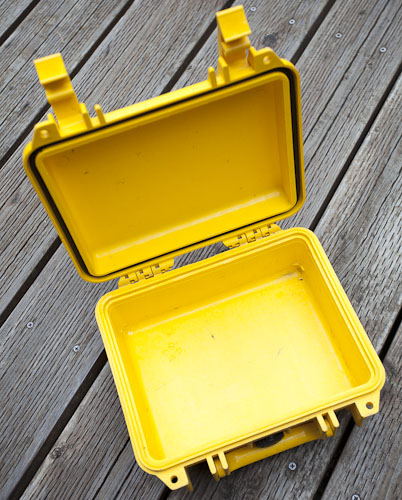
September, Bowron Lakes, BC. I got caught in a rookie mistake last week, on the Bowron Lake Canoe Circuit in British Columbia. I punched a hole in the bottom of my fiberglass Necky Eliza kayak during a portage when the padding on the aluminum rails of my cart slipped off. As I hauled the loaded kayak up the rock-strewn trail, the boat bounced on the cart rail until a hole punched in through the keel. I never checked for hull damage, and two hours later, after paddling the length of Indianpoint Lake, I discovered a two-gallon mess of water in the stern compartment of my boat. But that really wasn’t the mistake.

Smart kayakers know that leaks happen, eventually, if you paddle enough. There’s simply too many places where water can enter for the supposedly dry compartments to remain water free. Leaky bulkhead, leaky hatches. There’s holes in every boat for fittings, deck mounts, skeg and rudder cables. Then there’s accidents like dropped boats or not-so-accidents like bashing into rocks. So we put gear inside drybags and dry boxes for extra protection. Drybags aren’t perfect, however, and, given a veritable bathtub of water, it’s likely some will seep in. Indeed, three of four drybags had water inside, though not much harm done except some wet cashews. What shocked me was my reliable Pelican Mini S case—the drybox that housed a 300mm f/4 lens, 1.4x tele-converter, TC-80N3 remote switch, a bunch of compact flash cards, filters and cleaning kit—was soaked on the inside. I was lucky that the breach occurred on freshwater, not salt. My gear recovered. But what caused the breach?
The Pelican box was 15 years old and the gasket had never been replaced. I had also jammed a 300mm f/4 into it, actually bulging out the side of the box a bit to squeeze the lens in. So the gasket was my first suspect. Either through age or abuse, it was surely the culprit. The cause, however, turned out to be simpler.

An open purge valve.
All but the smallest of Pelican boxes have a purge valve to allow equalization of pressure inside and out, in order to open the box. For example, if you close the box at a 5,000 foot elevation, cart the case to sea level, and try to open it, you may be out of luck as the relative pressure inside vs. out serves like a clamp to squeeze the lids together. The same thing can happen if you close the case in a hot room, and later try opening it in the cold outdoors. Opening the purge valve draws in some air, equalizes the pressure, and the box can be snapped open. Some time ago—like way beyond memory—I had unscrewed the purge valve a turn or two, probably when I had difficulty opening the box. Back in the present, the flood in the stern was so deep it swamped the open hole, water seeped into the box, and expensive camera gear loss almost ensued.
If you have a recently-purchased Pelican box, it may be equipped with an automatic purge valve that won’t leak like mine did. These new valves have a Gore-tex membrane that allows air (gas molecules) to pass through, providing the purge function, but it blocks liquid water due to liquid’s much larger size (according to Gore, the membrane pores are 20,000 times smaller than water droplets, but 700 times bigger than water vapor). Air and water vapor pass through, liquid water doesn’t.

If you have an old Pelican box, be sure the valve is closed while underway.
Gary